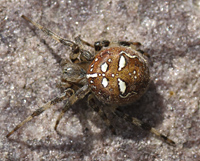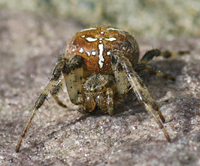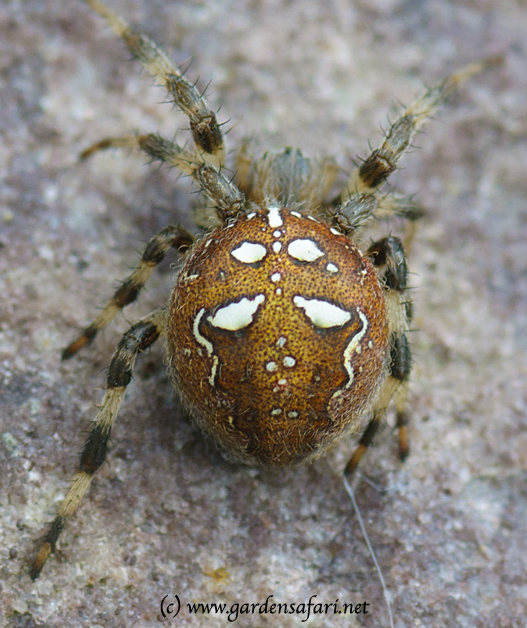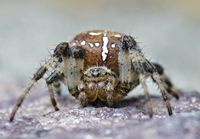[All pictures of garden wildlife on this page are thumbnails. Click on any thumbnail for a large format to be displayed.]

Four-spot orb weaver (Araneus quadratus)
| Taxonomy | ||||||
|---|---|---|---|---|---|---|
| Kingdom: | Phylum: | Class: | Order: | Family: | Genus: | Species: |
| Animalia | Arthropoda | Arachnida | Araneae | Araneidae | Araneus | A. quadratus |
This pretty and colourful spider is almost as common as Araneus diadematus. In spite of its variable appearance, Araneus quadratus can be relatively easily identified by the four white spots on its abdomen and banded legs. Its colouring ranges from dark reddish brown to pale yellow or green. The darker the colour of the abdomen the more striking are the distinguishable four spots. The female reaches up to 18mm in lenth, the male is about half of this size. Especially females filled with eggs look impresivly huge.
Four-spot orb weaver can be usually found from June to October in low vegetation in grassland and heathland. It likes slightly humid and sunny spots. Its rounded web is typical for this family of spiders and reaches up to half a meter in diameter. Usually you won't encounter the spider sitting in the middle of the web as it hides in a funnel-shaped retreat close by. The hiding is constructed of a leaf or grass bundled with a thread. This is one of the features that distinguishes Araneus quadratus from Araneus diadematus as the latter usually hunts from the position in the middle of its web. When the Four-spot orb weaver hunts it holds a silky line that is connected to the web and that passes the signals of a visitor. Tha catch can be either a victim or a partner. The web is very strong and catches all kinds of insects from little flies and gnats to grasshoppers, wasps and damselflies. The victims are quickly tied around with silky string and injected with spider's killing venom that at the same time dissolves the victim's body. Four-spot orb weaver can only take food in liquid form so the peculiar 'digestion' already has to start outside of the spider's body. The remnants of the food are being removed from the web by cutting off the threads holding them in the web. Older web sections with threads that lost their stickiness are being eaten by the spider and replaced by fresh ones.
The main natural enemies of Four-spot orb weaver are birds, bats, frogs and hornets.
By the end of September and in October the female lays eggs and packes them in a cocoon in which the eggs safely overwinter.In spring the young tiny spiders with a black spot on the abdomen crawl out of their winter home. In the beginning the baby spiders all stick together and over time they scatter around to build the webs of their own.

© Copyright 1998-2024 gardensafari.net (Hania Berdys)

 English / engels
English / engels  Dutch / nederlands
Dutch / nederlands




